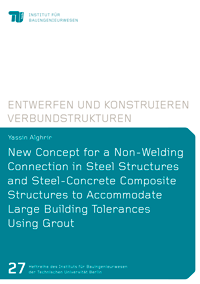
Shop : Details
Shop
Details
49,80 €ISBN 978-3-8440-7313-3Softcover214 pages203 figures317 g24 x 17 cmEnglishThesis
April 2020
Yassin Alghrir
New Concept for a Non-Welding Connection in Steel Structures and Steel-Concrete Composite Structures to Accommodate Large Building Tolerances Using Grout
Accommodation of tolerance in huge buildings is one of the challenges confronting the site engineer. Dimensional variation and the accuracy of positioning structural elements are more critical concerns in huge buildings than in other types of structures. The accumulation of the dimensional variations in such structures is significant due to the large dimensions and the dependency of each element on the previous erected element in a long series of successive steps throughout the construction process. Therefore, in this research, with an eye toward tolerance accommodation in huge multi-storey buildings, an adaptable grouted connection is suggested.
The research deals primarily with the strength characteristics of a grouted connection proposed to be employed between steelto-steel elements or steel-to-concrete elements. The connection has been designed and tested at TU Berlin in the department of Composite structures (Verbunstrukturen). It consists of two toothed steel plates and grout in between; three types of grout have been used. The commercial names of the grout are BETEC180, COMPONO, and Sikadur-42; BETEC180 belongs to the family of high-performance cementitious grout, whereas COMPONO and Sikadur-42 relate to polymer concrete. Though the compressive strengths of all grout are close, there are substantial differences in the tensile and shear capacity between the cementitious grout and the polymer concrete grout.
Firstly, to investigate the performance of the connection under vertical shear, three tests for each material are conducted. The connection of cementitious grout showed brittle performance, and cracks started to propagate under relatively small loads. On the other hand, the polymer concrete connections displayed more ductile behavior in contrast to the BETEC connection; the displacements of the COMPONO and Sikadur-42 connections are 4.5 and 1.7 times, respectively, the displacements of the BETEC connection. Also, the ultimate strength of the COMPONO and Sikadur-42 connections is 81% and 74% greater than the parallel strength of the BETEC connection, respectively. Sikadur-42 connection presents the best behavior in terms of ductility and load capacity. However, the failure mode is comparable in all connections.
In order to demonstrate the connection’s behavior and to trace the development of stresses and strains inside the connection, three-dimensional nonlinear Finite Element Models (FEM’s), for the three different materials, have been carried out using ANSYS software. The FEMs exhibits reasonable good behavior and compatibility with the observations in the experiments. The models are useful in interpreting the stress development within the grout and the failure mode of the connection. Furthermore, the load capacities of the models tie in well with the test outcomes.
In order to calculate the strength of the connection, analytical approaches have been developed. The calculation procedure relies on a strut and tie model and the FEMs. The calculations distinguish between two phases; before and after cracking of the grout. The Utilization of the outcomes from the FEMs improves the results of the analytical approaches. The proposed theoretical approaches are sufficiently accurate to estimate the strength at the level of first cracks and to determine the ultimate strength of the connection.
The research deals primarily with the strength characteristics of a grouted connection proposed to be employed between steelto-steel elements or steel-to-concrete elements. The connection has been designed and tested at TU Berlin in the department of Composite structures (Verbunstrukturen). It consists of two toothed steel plates and grout in between; three types of grout have been used. The commercial names of the grout are BETEC180, COMPONO, and Sikadur-42; BETEC180 belongs to the family of high-performance cementitious grout, whereas COMPONO and Sikadur-42 relate to polymer concrete. Though the compressive strengths of all grout are close, there are substantial differences in the tensile and shear capacity between the cementitious grout and the polymer concrete grout.
Firstly, to investigate the performance of the connection under vertical shear, three tests for each material are conducted. The connection of cementitious grout showed brittle performance, and cracks started to propagate under relatively small loads. On the other hand, the polymer concrete connections displayed more ductile behavior in contrast to the BETEC connection; the displacements of the COMPONO and Sikadur-42 connections are 4.5 and 1.7 times, respectively, the displacements of the BETEC connection. Also, the ultimate strength of the COMPONO and Sikadur-42 connections is 81% and 74% greater than the parallel strength of the BETEC connection, respectively. Sikadur-42 connection presents the best behavior in terms of ductility and load capacity. However, the failure mode is comparable in all connections.
In order to demonstrate the connection’s behavior and to trace the development of stresses and strains inside the connection, three-dimensional nonlinear Finite Element Models (FEM’s), for the three different materials, have been carried out using ANSYS software. The FEMs exhibits reasonable good behavior and compatibility with the observations in the experiments. The models are useful in interpreting the stress development within the grout and the failure mode of the connection. Furthermore, the load capacities of the models tie in well with the test outcomes.
In order to calculate the strength of the connection, analytical approaches have been developed. The calculation procedure relies on a strut and tie model and the FEMs. The calculations distinguish between two phases; before and after cracking of the grout. The Utilization of the outcomes from the FEMs improves the results of the analytical approaches. The proposed theoretical approaches are sufficiently accurate to estimate the strength at the level of first cracks and to determine the ultimate strength of the connection.
Keywords: Non welding connection; Strut and Tie model; Grout; Polymer concrete; Finite element analysis
Heftreihe des Instituts für Bauingenieurwesen / Book Series of the Department of Civil Engineering, Technische Universität Berlin
Edited by Prof. Dr.-Ing. Matthias Barjenbruch, Prof. Dr.-Ing. Karsten Geißler, Prof. Dr.-Ing. Reinhard Hinkelmann, Prof. Dr.-Ing. Wolfgang Huhnt, Prof. Dr.-Ing. Yuri Petryna, Prof. Dr.-Ing. Frank Rackwitz, Prof. Dr. sc. techn. Mike Schlaich, Prof. Dr.-Ing. Volker Schmid, Prof. Dr.-Ing. Matthias Sundermeier and Prof. Dr.-Ing. Frank U. Vogdt, Berlin
Volume 27
Available online documents for this title
You need Adobe Reader, to view these files. Here you will find a little help and information for downloading the PDF files.
Please note that the online documents cannot be printed or edited.
Please also see further information at: Help and Information.
Please also see further information at: Help and Information.
| Document |  | Abstract | ||
| Type |  | |||
| Costs |  | free | ||
| Action |  | Download the file | ||
| Document |  | Document | ||
| Type |  | |||
| Costs |  | 37,35 € | ||
| Action |  | Purchase in obligation and download the file | ||
| Document |  | Table of contents | ||
| Type |  | |||
| Costs |  | free | ||
| Action |  | Download the file | ||
User settings for registered online customers (online documents)
You can change your address details here and access documents you have already ordered.
User
Not logged in
Export of bibliographic data
Shaker Verlag GmbH
Am Langen Graben 15a
52353 Düren
Germany
Am Langen Graben 15a
52353 Düren
Germany
Mon. - Thurs. 8:00 a.m. to 4:00 p.m.
Fri. 8:00 a.m. to 3:00 p.m.
Fri. 8:00 a.m. to 3:00 p.m.
Contact us. We will be happy to help you.



